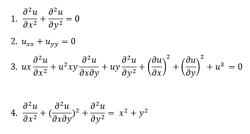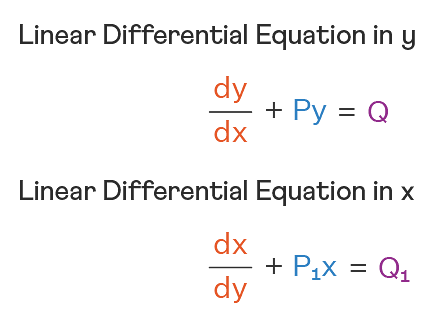Solution of \(
(1 + xy) \, y \, dx + (1 - xy) \, x \, dy = 0
\) is?
Solution of \( (1 + xy) \, y \, dx + (1 - xy) \, x \, dy = 0 \) is?
Solution and Explanation
Problem:
The solution to the differential equation:
\[
(1 + xy) \, y \, dx + (1 - xy) \, x \, dy = 0
\]
is \( x^2 + y^2 = c \), where \( c \) is a constant.
Step 1: Rewrite the equation
The given equation is:
\[
(1 + xy) \, y \, dx + (1 - xy) \, x \, dy = 0
\]
Divide the whole equation by \( x^2 y^2 \) to simplify the terms:
\[
\frac{(1 + xy)}{x^2} \, dx + \frac{(1 - xy)}{y^2} \, dy = 0
\]
Step 2: Integrate both sides
Now we proceed to separate the variables and integrate both sides. Rearrange the terms so that the left side involves \( dx \) and the right side involves \( dy \):
\[
\frac{1 + xy}{x^2} \, dx = -\frac{1 - xy}{y^2} \, dy
\]
Step 3: Simplify and integrate
Each side can now be simplified, and after performing the integration (which involves standard integration techniques for rational functions), we obtain:
\[
x^2 + y^2 = c
\]
where \( c \) is an arbitrary constant of integration.
Final Answer:
Therefore, the solution to the differential equation is:
\[
x^2 + y^2 = c
\]
where \( c \) is a constant.
Top Questions on Differential equations
- If $ x + \frac{1}{x} = 4 $, find the value of $ x^4 + \frac{1}{x^4} $.
- BITSAT - 2025
- Mathematics
- Differential equations
- If $ a, b $ are roots of the equation $ x^2 - 5x + 6 = 0 $, find the value of $ a^3 + b^3 $.
- BITSAT - 2025
- Mathematics
- Differential equations
- If 'a' and 'b' are the order and degree respectively of the differentiable equation \[ \frac{d^2 y}{dx^2} + \left(\frac{dy}{dx}\right)^3 + x^4 = 0, \quad \text{then} \, a - b = \, \_ \_ \]
- KCET - 2025
- Mathematics
- Differential equations
- Let \( y = y(x) \) be the solution of the differential equation \[ \cos(x \log(\cos x))^2 \, dy + (\sin x - 3 \sin x \log(\cos x)) \, dx = 0, \quad x \in \left( 0, \frac{\pi}{2} \right) \] If \( y\left( \frac{\pi}{4} \right) = -1 \), then \( y\left( \frac{\pi}{6} \right) \) is equal to:
- JEE Main - 2025
- Mathematics
- Differential equations
- Let \( y = y(x) \) be the solution of the differential equation \( \frac{dy}{dx} + 3(\tan^2 x) y + 3y = \sec^2 x \), with \( y(0) = \frac{1}{3} + e^3 \). Then \( y\left(\frac{\pi}{4}\right) \) is equal to
- JEE Main - 2025
- Mathematics
- Differential equations
Questions Asked in MHT CET exam
- If \( \tan^{-1} (\sqrt{\cos \alpha}) - \cot^{-1 (\cos \alpha) = x \), then what is \( \sin \alpha \)?}
- MHT CET - 2025
- Trigonometric Identities
- A die was thrown \( n \) times until the lowest number on the die appeared. If the mean is \( \frac{n}{g} \), then what is the value of \( n \)?
- MHT CET - 2025
- Probability
- Evaluate the integral: \[ \int \frac{\sqrt{\tan x}}{\sin x \cos x} \, dx \]
- MHT CET - 2025
- Integration
- A coil of 100 turns, carrying a current of \( 5 \, \text{A} \), is placed in a magnetic field of \( 2 \, \text{T} \). The area of each turn is \( 0.01 \, \text{m}^2 \). What is the magnetic moment of the coil?
- MHT CET - 2025
- Magnetism and matter
- Two point charges \( +2 \, \mu\text{C} \) and \( -3 \, \mu\text{C} \) are placed 10 cm apart in vacuum. What is the electrostatic force between them?
- MHT CET - 2025
- coulombs law
Concepts Used:
Types of Differential Equations
There are various types of Differential Equation, such as:
Ordinary Differential Equations:
Ordinary Differential Equations is an equation that indicates the relation of having one independent variable x, and one dependent variable y, along with some of its other derivatives.
\(F(\frac{dy}{dt},y,t) = 0\)
Partial Differential Equations:
A partial differential equation is a type, in which the equation carries many unknown variables with their partial derivatives.

Linear Differential Equations:
It is the linear polynomial equation in which derivatives of different variables exist. Linear Partial Differential Equation derivatives are partial and function is dependent on the variable.

Homogeneous Differential Equations:
When the degree of f(x,y) and g(x,y) is the same, it is known to be a homogeneous differential equation.
\(\frac{dy}{dx} = \frac{a_1x + b_1y + c_1}{a_2x + b_2y + c_2}\)
Read More: Differential Equations